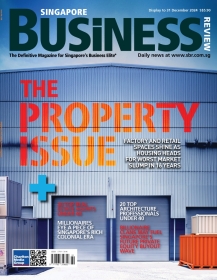
Will Singapore economy kick strongly in the year of the wooden horse?
Analysts have mixed predictions.
Singapore ended 2013 with a rather disappointing economic contraction. According to UOB, advance estimates of 4Q GDP showed a growth of 4.4% y/y (-2.7% q/q SAAR), lower than consensus estimates of 4.8% y/y (-1.3 % q/q SAAR).
Weaker-than-expected growth came from the q/q pullback seen across the goods and services producing industries. For example, on a q/q saar basis, manufacturing declined 4.0%, construction fell 6.9%, and services industries declined 1.7%. The q/q pullback was due mainly to a higher base reached in the previous quarter.
Here's what analysts have to say on Singapore's soft year-end and their prediction for 2014.
Francis Tan & Jimmy Koh, UOB Economic-Treasury Research:
Although we are more optimistic on Singapore’s economic growth in 2014, there are several downside risks to our forecast. First, the implementation of QE tapering and uncertainty over the raising of the US debt ceiling will induce another round of volatility to the financial markets and business confidence globally.
Particularly, QE tapering will impose downside risks on companies with longer-tenor loans in their books. Interest costs may rise
and affect firm’s cash flow and overall margins. We expect the USD to move stronger against the SGD and may reach 1.33 by end of 2014. That said, this bout of USD strength could weigh on companies with unhedged accounts payables in USD, while importers may face margins pressures as costs of goods sold edge higher.
On the domestic front, we will continue to see slower demand on our PC-related exports as the world moves deeper into the smart-phone/tablet era. As such, PC-related manufacturers and service providers may continue to see lower business volume.
Our export cost-competitiveness could be eroded further as the tight labour market condition brings about higher wage costs for firms. Other than a constrained labour supply growth rate, the employment pass qualifying salary increase in January 2014 and another wave of foreign worker levies increase in July 2014 will increase cost pressures. Industrial rentals rose 7.6% y/y in the first 3 quarters of 2013 and if it continues in a similar fashion in 2014, bottom-lines of manufacturers will be affected yet again.
As the economic climate in 2014 will be relatively better, it will be of no doubt that some of the cost increase will eventually be passed on to consumer prices. As such, our forecast of 2014 inflation rate of 3.3% (compared to 2.6% estimate for 2013) remains unchanged for now, and it is also with this phase of higher growth and added inflationary pressures in our domestic economy (and an expected stronger USD), that we believe the MAS will hold on to their stance of “modest and gradual appreciation” of the SGD NEER in April 2014.
Irvin Seah, senior economist, DBS Research:
The economy is expected to contract by 2.7% QoQ saar in the fourth quarter. This translates into a year-on-year expansion of 4.4%, which brings full year GDP growth to 3.7%, much in line with our forecast of 3.8%.
While the pullback in growth amid improving global outlook may reflect an underperformance in the Singapore economy, we need to be mindful that the advance GDP estimates, particularly for the QoQ figures, can be rather unreliable in recent years, often subjected to significant revision and switching between negative and positive numbers. So take this figure with a pinch of salt. Our take is that it could be revised up to a less severe contraction about -0.8% QoQ saar when the final figure is out.
So the economy did end 2013 on a sluggish note. Well, it shouldn’t come as a surprise given the cyclical downswing in the biomedical cluster, post-festive season moderation in the electronics sector, as well as risk aversion in the financial market from QE tapering fear. The key question now is whether such underperformance will persist into 2014. The answer is no.
Put in perspective, the three factors that drag growth down in 4Q13 are transient in nature. One is industry specific, the other is seasonal in nature, and the last is sentiment driven. Their effects are unlikely to be sustained for long.
Firstly, the slump in biomedical is industry specific. Apart from its effect on the GDP growth figure, it has little impact on the rest of the economy due to its weak linkages with the rest of the economy. Moreover, such cyclical swings are typical of the nature of this industry. Production could well spike in the coming months.
Secondly, while the electronics industry is clearly on a recovery path, festive season demand has injected additional impetus to sales and production between Aug-Oct13. So with most of the orders delivered by October, export sales and production will obviously moderate. That is, the moderation in electronics is seasonal in nature and it doesn’t imply that external demand is collapsing. On a longer term basis, demand will continue to rise on improvement in the global outlook.
Indeed, the economic conditions in the external environment are improving. And this could drive sentiments back up in the coming months. Moreover, the reaction from the financial market immediately after the Fed has announced tapering in December was fairly muted. The fear and risks of QE was somewhat over-exaggerated. Ultimately, QE tapering is NOT monetary policy contraction. In fact, US monetary policy is still expansionary in nature, just less so than what it used to be.
As it is, Eurozone is no longer a drag on the global economy. The US will continue to muddle along this sluggish recovery path. Asia will outperform in 2014, led by stronger growth in China. Against this improved global backdrop, Singapore’s economic growth will inch a bit higher to 4.0% in 2014. That said, it could well have been higher if not for the structural constraints imposed by the restructuring. But that’s another story for another day.
Edward Lee Wee Kok & Jeff Ng, analysts, Standard Chartered:
According to the Ministry of Trade and Industry, the moderation in manufacturing growth was due to the contraction in biomedical manufacturing and slower growth in transport engineering. Indeed, biomedical manufacturing grew only 3.2% in 11M-2013, compared with 11.3% growth in 11M-2012. Transport engineering also had a subdued year, growing 3.9% in 11M-2013, versus 12.5% the previous year. On a more positive note, the electronics’ sector appears to have found a bottom: it grew 2.3% in 11M-2013, versus -10.2% over the same period in 2012.
The slowdown in the service sector in Q4 was driven by slower growth in the wholesale and retail trade, and finance and insurance sub-sectors. Daily stock value turnover in Q4-2103 was, on average, about 20% lower than in Q4-2012. Despite the moderate recovery in the manufacturing sector, the service sector remained the main contributor to growth in 2013.
We expect Singapore’s GDP growth to accelerate to 4.4% in 2014, supported by net external demand. This is slightly higher than the government’s forecast of 2-4%. Global PMIs have remained positive, hinting at stronger industrial production globally and more demand for Singapore’s exports (see Figure 3). Externally-oriented sectors are likely to benefit as the US and Europe recover and move towards trend growth. We think that GDP growth in the US will accelerate to 2.4% in 2014 from 1.7% in 2013, while growth in Europe rebounds to a positive 1.3%, from a 0.4% contraction in 2013. Stronger domestic demand from rising confidence and household incomes in the US and Europe are likely to boost demand for Singapore’s exports. At the same time, China’s GDP growth will likely remain resilient, supported by domestic consumption and export growth.
Overall, we think that a stronger performance in externally-oriented sectors will more than make up for the likely consolidation in domestic sectors due to the tight labour situation and a cooling property market
























 Advertise
Advertise






